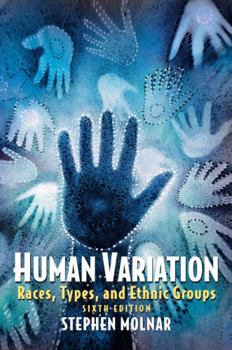Human Variation: Races, Types, and Ethnic Groups
Select Format
Select Condition 
Book Overview
Basic text for the sophomore/junior level course in Human Variation or Human Diversity taught anthropology or biology departments.
This classic introduction to human variation, has been thoroughly updated to include the issues and controversies facing the contemporary study of diversity.
Format:Paperback
Language:English
ISBN:0131927655
ISBN13:9780131927650
Release Date:December 2005
Publisher:Routledge
Length:448 Pages
Weight:1.20 lbs.
Dimensions:0.7" x 6.5" x 9.0"
Customer Reviews
3 ratings
dry but beneficial
Published by Thriftbooks.com User , 15 years ago
Molnar's text begins (for most of the book) in science and the search for categorising differences caused by mutation and adaptation. It then moves to biology... for the rest of the book with maybe a chapter or two on straight history. If you want to discover the truth about why there is no biological basis for "race" I highly suggest this book, read along with Brace's "Race is a Four-Letter Word".
Human Variation and Genetics
Published by Thriftbooks.com User , 19 years ago
Molnar's book is a wonderful introduction to human genetics, variation, and racial classification (that is, race is an illusion), just as the title suggests. Parts of the book are highly involved and technical, giving both the amateur and the professional room for learning. The book would be great for undergrads and graduate students.
A diverse, useful, yet disorganized work on human variation.
Published by Thriftbooks.com User , 21 years ago
Having survived a quarter-long course in anthropology using this as a textbook, I've acquired a pretty good feel for its strengths and its faults.Let's start with the latter and work toward the former. What will bother most people is the occasionally lacking organization/illustration of the subject matter. While this is fine in a college environment, the layman can easily get lost in its pages. The chapters were probably practical enough from the author's perspective, the bulk going from one "racial" feature to another and exposing the actual evolutionary roots, but I would have liked more theoretical continuity.Also, despite the mass of excellent data, the book lacks a proper genetic analysis of human variation. Research has given us an idea of how far various conventional "groups" are from each other, genetically speaking--sometimes in direct contravention to the expected associations. This sort of analysis is elementary to tracking our remarkable journey into the far reaches of the world, and should not be omitted in a text that considers what happened in the process.As an extension of my first complaint, it's the lack of theoretical perspective which makes "A reader's" review possible. Had the author made the meta-scientific point of race being an irrelevant construct, my fellow reviewer would not have spoken of "...the big *racial* differences in size, speed, leaping ability, and muscularity...," since there are quite valid selective factors behind such variation, independent of any perceived "race." To Molnar's credit, he *does* take a look at stature in its evolutionary context. In any case, one must not turn "a feature present in people seen as belonging to a race" into "a racial feature." Accordingly, Molnar should have noted the inherent logical circularity of racial distinctions: Races are defined by certain features, and those features are racial because they define races. How do they define races? Because races have them. What defines a race? Those features. It is our perceptual emphasis on apparent differences that creates racial categories, and only secondarily do some intrepid pseudo-scientists attempt to provide a more sophisticated academic "justification" of those categories. This book is rife with detailed information to use against these sorts, but it helps to grasp the bigger picture in advance.Ultimately, Molnar fails to ask a rather philosophical question: What makes a category scientifically real? If you're going to say that races don't really "exist," the standard of existence must be made explicit. The short answer is that things are scientifically real insofar as they fit into science's theoretical machine; in this case, evolutionary theory and its applications. The concept of distinct "races" arose in less enlightened times, and it is thus incommensurable with the language of modern biology. Science has no use for it, since, functionally, there is only the genetic paint of human inheritance spread over a geographical






